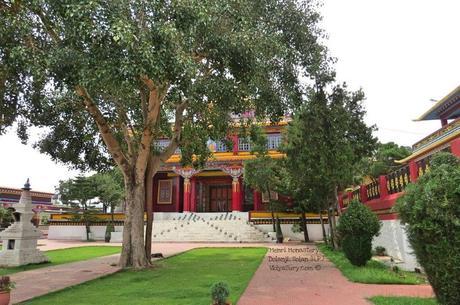
During our trip to Kasauli in Himachal Pradesh a few weeks ago, we visited the Menri Monastery, or Yung Drung Ling in Dolanji, Solan.
Long story how we got there. We had booked our tickets to Chandigarh but were undecided about which places to visit in Himachal Pradesh once we go there. We were, of course, spoilt for choice, but it was also right in the middle of the monsoons, which usually means landslides in that area. We made a number of itineraries to make the best use of the five days we had at our disposal.
I talked to friends. And while on my weekly marathon call with my BFF, she suggested Shimla. She's currently in LA on vacation and is enjoying herself in one of the Los Angeles mansions, after which she plans to indulge in the local attractions for a couple of weeks before she returns home. Yes, she wished I was there, too and is dazzling me with her photos. Perhaps, soon. Sooner than I think.
In the meantime, we finalized our trip and decided to go to Kasauli, and from there, take a day trip to Barog and Solan. On the day we arrived at Kasauli, we walked around, enjoying the little town. The next day, after a pleasant breakfast, we set out to see Manki Point, from where we headed off towards Solan via Barog. I would go into detail about these places, but today's focus is the Menri Monastery.
Our cabbie for the day had no idea what we meant when we said Menri Monastery. Apparently, the locals refer to it as the Buddhist monastery, which it isn't! Finally he figured out that it is near Rajgarh, in a village called Dolanji in Solan district. It would have been easy to miss the little road diversion at Ochghat, but luckily, we stopped to ask someone and they pointed us in the right direction, which was a road of sorts. A little doubtfully, we followed the route and to our delight, arrived at our destination- the Menri Monastery.
After we got off our car, we followed the wall of the monastery to its gate, and what we saw there literally took our breath away.
The brilliant colors of the monastery's buildings against the backdrop of the skies and shades of green from any vantage point formed a serene setting. Utter peace reigns, with the occasional ringing of a gong.
I was amused to see the young monks going about their day, headphones in their ears and was curious to know what they were listening to. Some ran down the steps leading up to the monastery from the shopping area below.
It was charming to see that everyone we came across had a sweet smile and a nod, as if we were old friends.
This beautiful monastery has an interesting history.
The original Menri Monastery was established in 1405 in Tsang, Tibet, as the main Bon monastery. When its founder, Tonpa Shenrab went to Kongpo, he took a break at Tobgyel. The story goes that he left a footprint in a rock, saying that the future of the monastery would be there. The mountains behind and around Menri monastery are full of medicinal plants and medicinal springs and Menri gets its name from this, meaning "medicine mountain".
Sadly, the original Menri monastery at Tibet was destroyed and Bon followers reestablished their spiritual center at Dolanji, naming it after the monastery in Tibet. The area is also called Tobgyel Sarpa after the village Tobgyel which was near the ancient monastery of Menri in the Tsang province of Tibet.
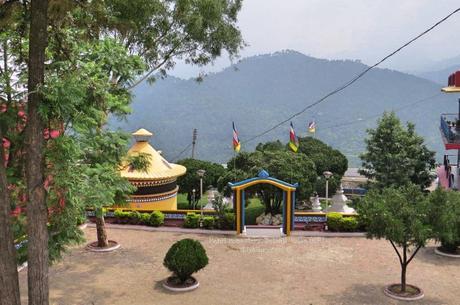
Bon religion dates back to the 7 th century, and originated around the same time as Buddhism. It is the oldest spiritual traditon of Tibet. Bon had to fight for its identity, and in 1978, the Dalai Lama acknowledged it as a school with its own doctrine and practices during his visit to the monastery. Those who follow Bon are called Bonpo and wear dark maroon robes with a royal blue vest, unlike Buddhist monks who wear yellow and orange robes.
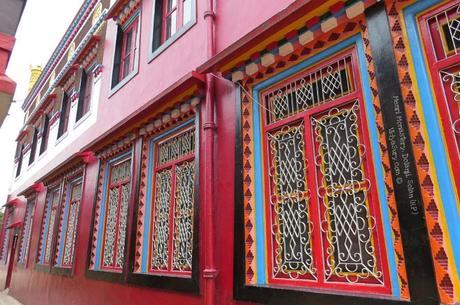
When the Chinese occupied Tibet in 1959, a large number of Tibetans fled from there and many were Bonpo. Most of the residents at the present-day Menri monastery are originally from the Kailash Mansarovar and Tsang regions. In 1969, steered by the abbot of Yungdrung Ling, the second most important Bon monastery of Tibet, the followers of Bon at Dolanji elected their Abbot, Menri Trizin thirty third Lungtok Tenpai Nyima and he's now the head of all the Bon monasteries and institutions worldwide.

Here is an excerpt from Tibetan gYung-Drung Bon Monastery in India by Lopon Tenzin Namdak, Dolanji, 1983
According to tradition, Bon originated in the land of Olmo Lungring, located in a larger country known as Tazig. Ol symbolizes the unborn; Mo the undiminishing; Lung the prophetic words of Tonpa Shenrab, the founder of Bon; and Ring his everlasting compassion. Olmo Lungring constitutes one-third of the existing world and is situated to the west of Tibet. It is described as an eight-petalled lotus under a sky which appears as an eight-spoked wheel. In the center rises Mount gYung-Drung Gutseg, which symbolizes permanence, indestructibility, and the Nine Ways of Bon. At the base of Mount gYung-Drung spring four rivers flowing towards the four cardinal directions. The mountain is surrounded by temples, cities, and parks. To the south lies the palace Barpo Sogye where Tonpo Shenrab was born. To the west and north are the palaces in which the wives and children of Tonpa Shenrab lived. The temple Shampo Lhatse is to the east. The complex of palaces, rivers, and parks with Mount gYung-Drung in the center constitutes the inner region of Olmo Lungring. The intermediate region consists of twelve cities, four of which are aligned with the cardinal directions. The third region includes what is known as the outer land. These three regions are encircled by an ocean and by a range of snowy mountains. Access to Olmo Lungring is gained by the arrow way, which takes its name from an episode in the life of Tonpa Shenrab who, before visiting Tibet, is said to have shot an arrow to create a passage through a previously impenetrable mountain range.Some scholars relate this traditional description of Olmo Lungring to Mount Kailash and the four great rivers which spring from its base. Others believe it may refer to the geography of the Middle East and Persia at the time of Cyrus the Great. To the Bonpo, specific geographic identification is less important than the mythological origins of their religion. As Lopon Tenzin Namdak has pointed out, symbolic descriptions which combine history, geography, and mythology are well-known in ancient scriptures.From: Opening the Door To Bön, Snow Lion Publications, 2005
Historical Bön texts state very clearly that the holy mountain Mount Kailash was in the center of the Kingdom of Zhang Zhung, which was the closest neighboring kingdom to Tibet and existed until the end of the eighth century. Zhang Zhung was integrated into Tibet after the death of the Emperor Ligmincha, its last ruler. In early times the Kingdom of Zhang Zhung extended from what is today the upper part of western Tibet, through parts of Nepal, northern India (Ladhak, Zangskar, Kinnaur, Spiti, etc.), to Pakistan (Kashmir) and to China (the Karakoram area). Most of the Bön teachings have been translated from the Zhang Zhung language into Tibetan.Mount Kailash is a holy place for Bönpos and is blessed by the Zhang Zhung deity Me Ri. The Me Ri teachings were among the main practices of the Zhang Zhungpa (people of Zhang Zhung) and were later introduced into Tibet. The lineage of this practice has been preserved, and it continues to the present time.
At the Menri Monastery, Dolanji, Solan in Himachal Pradesh
Secluded from the city, the Menri monastery overlooks the valley and is a hub for religious learning and rituals. From being a basic facility in 1998 with a hundred monks, the temple complex has grown to 350 residents, with a number of buildings built in Tibetan style, including a library, main temple, dormitories for the monks, Bon Dialectic School, a health center, a nunnery and more.
It is a self-contained township in itself. Today, the monastery is overseen by the 33rd Abbot of Menri, His Holiness Lungtok Tenpai Nyima Rinpoche, who supervises all its affairs and is also considered the worldwide spiritual leader of the Bonpos and the Yungdrung Bon Monastic Center.
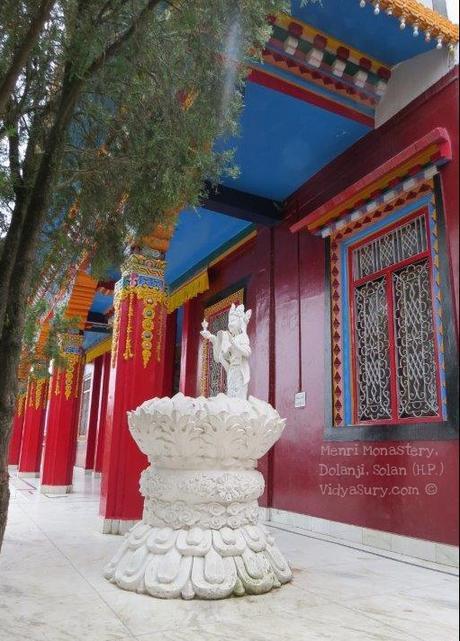
Across the river, the new Redna Menling Nunnery, which means "Land of Precious Medicine" is also headed by His Holiness. This is the only bonbo nunnery India where girls and women can now study for 18 years to become Geshema and teach the Dharma or Bön.
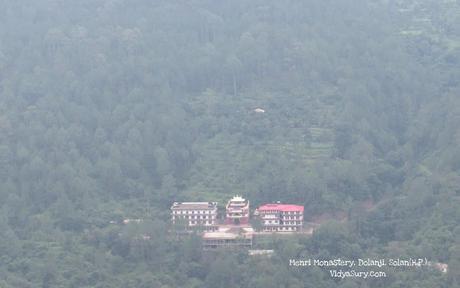
The monastery also looks after and educates more than 370 children from Nepal and Tibet. Located in the valley below the monastery, the Central School for Tibetans is run by the Indian government and the curriculum is the Bön educational program. The children stay in the Bon Children's Home in the Menri Complex in the dormitories. The boys are trained as monks and girls are placed in the nunnery to be trained as nuns. While leaving the monastery, we saw the children in the school grounds, happily doing the drill.
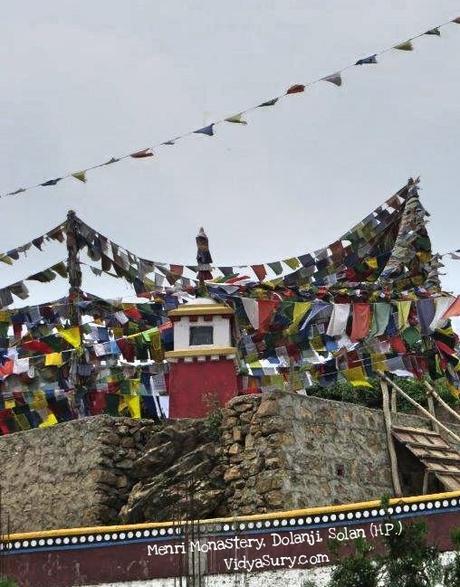
There is a new temple at the Menri complex, the "Yogi-Yogini temple" where people from the Dolanji community and visitors can stay and learn. I wish we had known about this earlier and would have loved to have stayed there. Perhaps next time!
I didn't know this, but apparently the Tibetan prayer flags originate from the ancient Bon culture. They symbolize the union and balance of the five elements, and are believed to transmit prayer and acknowledge the divine.
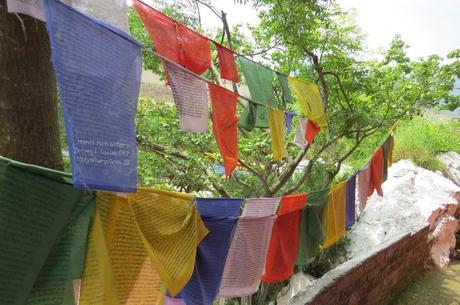
We saw quite a few monkeys there-they are everywhere in Himachal Pradesh.
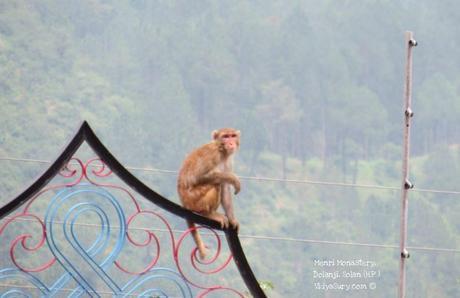
We took the steps back to the entrance to meet our car, and on the way, saw this court, where a few young monks were dribbling with a ball, while others just stood around and chatted.
What a wonderful trip! I could have just stood there and looked at the views all day!
Our drive back to Solan was beautiful-but then driving anywhere in Himachal Pradesh is a treat. We passed a number of orchards and our driver told us that in Ochghat he has undergone training to be a farmer.
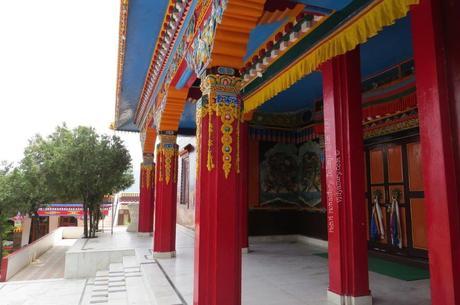
I will definitely visit the monastery again, and this time, make arrangements to stay there before I arrive. I hear that there is a huge statue of Shenrab Mibo in the monastery.
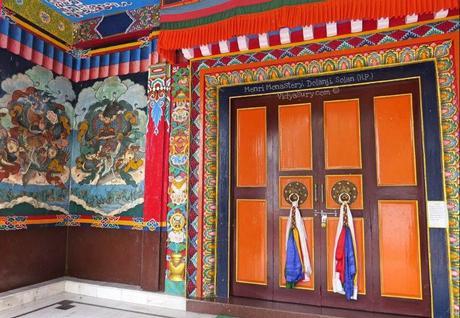
It is a pity we couldn't go inside the temple, watch the young monks pray, and share a meal with them. We heard that New Year's Eve is celebrated with much zest, with performances of the Cham and Bon dances and I do hope we make it there during that time.
Notes:The Menri Monastery is in Dolanji, about 15 kilometers from Solan along the Occhaghat-Narag road. It is better to ask at different points to avoid missing the kaccha road that leads to the monastery. If going by car, can take it all the way up to the parking lot right outside the monastery complex's gate. Of course you can also take the stairs leading up to the monastery.
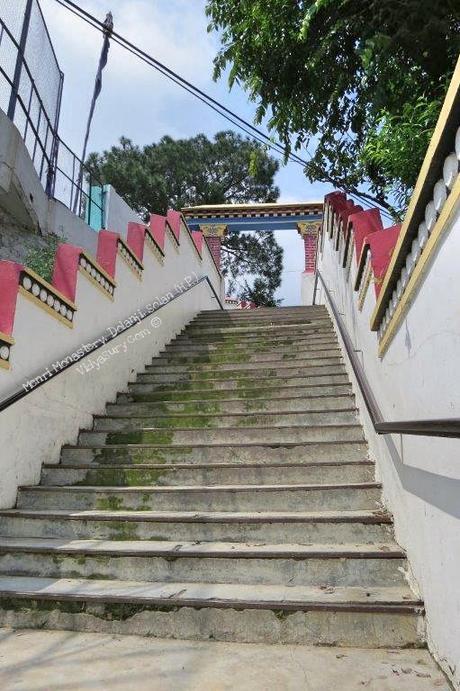
Chandigarh is the nearest airport and one could take a cab directly from there to Menri - approx. 70 kilometers.
Other places to see on the way are the famous Jatoli Temple and Shoolini Devi temple from which Solan gets its name. We didn't go up there as we were running short on time, and instead, satisfied ourselves by clicking a photo from the winding road. The architecture looks beautiful. T
Definitely carry water. The weather was supposed to be wet-but it turned out to be a scorching day and we congratulated ourselves for carrying several bottles of water. Habit.
The problem with Himachal Pradesh is always this: one wants to stop often to see beautiful places that are not listed anywhere. The good news is, there's so much left to see-always.
♥
Where did you travel recently?
Writer, editor, blogger, social media enthusiast. Love DIY, Coffee, Music, Reading, Photography, Family, Friends and Life. Mantra: Happiness is a DIY Project. In my free time I play with my dust bunnies and show my diabetes who's boss. Tweet as @vidyasury

